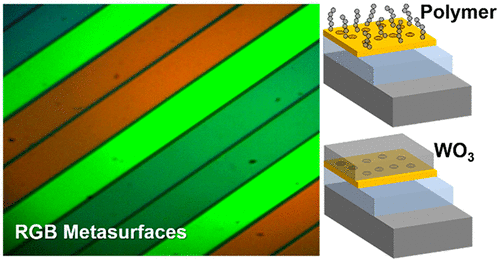当前位置:
X-MOL 学术
›
ACS Photonics
›
论文详情
Our official English website, www.x-mol.net, welcomes your
feedback! (Note: you will need to create a separate account there.)
High-Contrast Switching of Plasmonic Structural Colors: Inorganic versus Organic Electrochromism
ACS Photonics ( IF 6.5 ) Pub Date : 2020-05-28 , DOI: 10.1021/acsphotonics.0c00394 Marika Gugole 1 , Oliver Olsson 1 , Kunli Xiong 1 , Jolie C. Blake 1 , José Montero Amenedo 2 , Ilknur Bayrak Pehlivan 2 , Gunnar A. Niklasson 2 , Andreas Dahlin 1
ACS Photonics ( IF 6.5 ) Pub Date : 2020-05-28 , DOI: 10.1021/acsphotonics.0c00394 Marika Gugole 1 , Oliver Olsson 1 , Kunli Xiong 1 , Jolie C. Blake 1 , José Montero Amenedo 2 , Ilknur Bayrak Pehlivan 2 , Gunnar A. Niklasson 2 , Andreas Dahlin 1
Affiliation

|
Plasmonic structural colors have recently received a lot of attention. For many applications there is a need to actively tune the colors after preparing the nanostructures, preferably with as strong changes in the optical response as possible. However, to date, there is a lack of systematic investigations on how to enhance contrast in electrically induced color modulation. In this work we implement electrochromic films with plasmonic metasurfaces and compare systematically organic and inorganic materials, with the primary aim to maximize brightness and contrast in a reflective color display. We show nanostructures with good chromaticity and high polarization-insensitive reflectivity (∼90%) that are electrochemically stable in a nonaqueous solvent. Methods are evaluated for reliable and uniform electropolymerization of the conductive polymer dimethylpropylenedioxythiophene (PProDOTMe2) on gold. The resulting organic films are well-described by Lambert–Beer formalism, and the highest achievable contrast is easily determined in transmission mode. The optical properties of the inorganic option (WO3) require full Fresnel models due to thin film interference, and the film thickness must be carefully selected in order to maintain the chromaticity of the metasurfaces. Still, the optimized fully inorganic device reaches the highest contrast of approximately 60% reflectivity change for all primary colors. The switching time is about an order of magnitude faster for the organic films (hundreds of ms). The bistability is very long (hours) for the inorganic devices and comparable for the polymers, which makes the power consumption essentially zero for maintaining the same state. Finally, we show that switching of the primary colors in optimized devices (both organic and inorganic) provides almost twice as high brightness and contrast compared to existing reflective display technologies with RGB subpixels created by color filters.
中文翻译:

等离子结构颜色的高对比度切换:无机与有机电致变色
等离子结构色最近受到了广泛的关注。对于许多应用,需要在制备纳米结构之后主动地调整颜色,优选在光学响应中具有尽可能大的改变。但是,迄今为止,关于如何在电致彩色调制中增强对比度方面还缺乏系统的研究。在这项工作中,我们实现了具有等离子超表面的电致变色膜,并系统地比较了有机和无机材料,其主要目的是在反射型彩色显示器中最大化亮度和对比度。我们显示出具有良好色度和对偏振不敏感的反射率(〜90%)的纳米结构,这些结构在非水溶剂中具有电化学稳定性。2)在黄金上。兰伯特-比尔(Lambert-Beer)形式主义对所得的有机膜进行了很好的描述,并且在透射模式下可以轻松确定可获得的最高对比度。无机选项的光学性质(WO 3)由于薄膜干扰而需要完整的菲涅耳模型,并且必须仔细选择薄膜厚度以保持超表面的色度。尽管如此,针对所有原色,经过优化的完全无机的设备仍可达到最高的对比度,反射率变化约为60%。对于有机膜,切换时间大约要快一个数量级(几百毫秒)。对于无机装置,双稳态性非常长(小时),对于聚合物而言,双稳态性相当,这使得保持相同状态的功耗基本上为零。最后,我们证明,与使用彩色滤光片创建的RGB子像素的现有反射显示技术相比,在优化的设备(有机和无机)中切换原色可提供几乎两倍的高亮度和对比度。
更新日期:2020-07-15
中文翻译:

等离子结构颜色的高对比度切换:无机与有机电致变色
等离子结构色最近受到了广泛的关注。对于许多应用,需要在制备纳米结构之后主动地调整颜色,优选在光学响应中具有尽可能大的改变。但是,迄今为止,关于如何在电致彩色调制中增强对比度方面还缺乏系统的研究。在这项工作中,我们实现了具有等离子超表面的电致变色膜,并系统地比较了有机和无机材料,其主要目的是在反射型彩色显示器中最大化亮度和对比度。我们显示出具有良好色度和对偏振不敏感的反射率(〜90%)的纳米结构,这些结构在非水溶剂中具有电化学稳定性。2)在黄金上。兰伯特-比尔(Lambert-Beer)形式主义对所得的有机膜进行了很好的描述,并且在透射模式下可以轻松确定可获得的最高对比度。无机选项的光学性质(WO 3)由于薄膜干扰而需要完整的菲涅耳模型,并且必须仔细选择薄膜厚度以保持超表面的色度。尽管如此,针对所有原色,经过优化的完全无机的设备仍可达到最高的对比度,反射率变化约为60%。对于有机膜,切换时间大约要快一个数量级(几百毫秒)。对于无机装置,双稳态性非常长(小时),对于聚合物而言,双稳态性相当,这使得保持相同状态的功耗基本上为零。最后,我们证明,与使用彩色滤光片创建的RGB子像素的现有反射显示技术相比,在优化的设备(有机和无机)中切换原色可提供几乎两倍的高亮度和对比度。











































 京公网安备 11010802027423号
京公网安备 11010802027423号